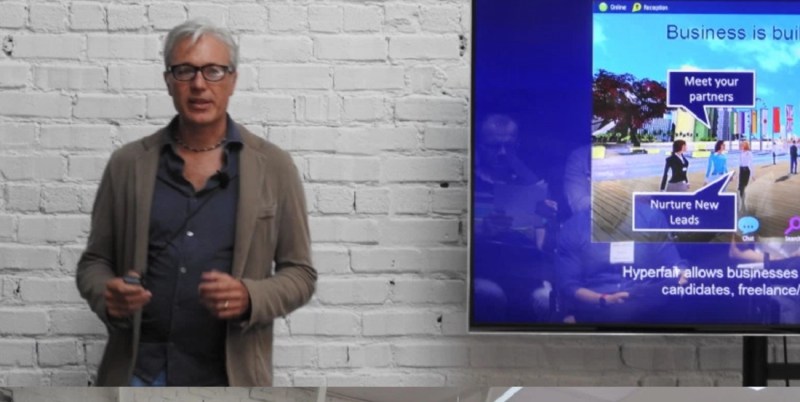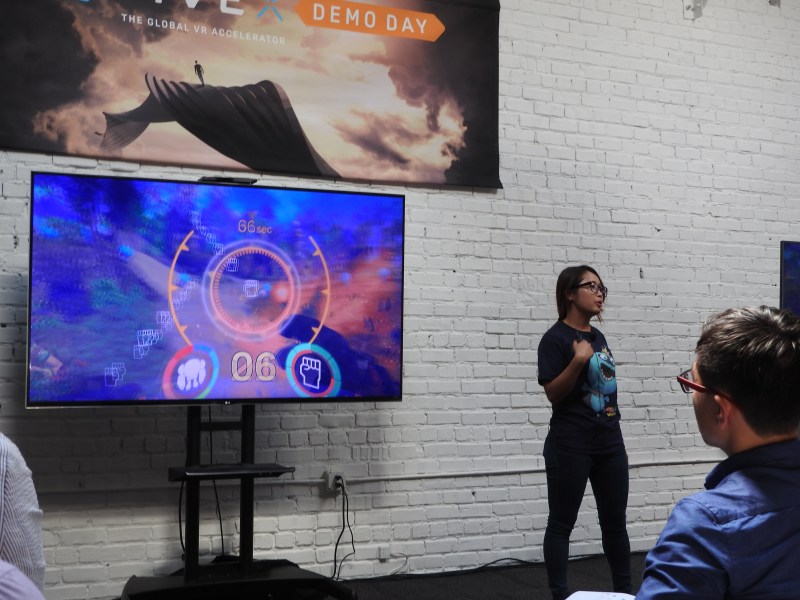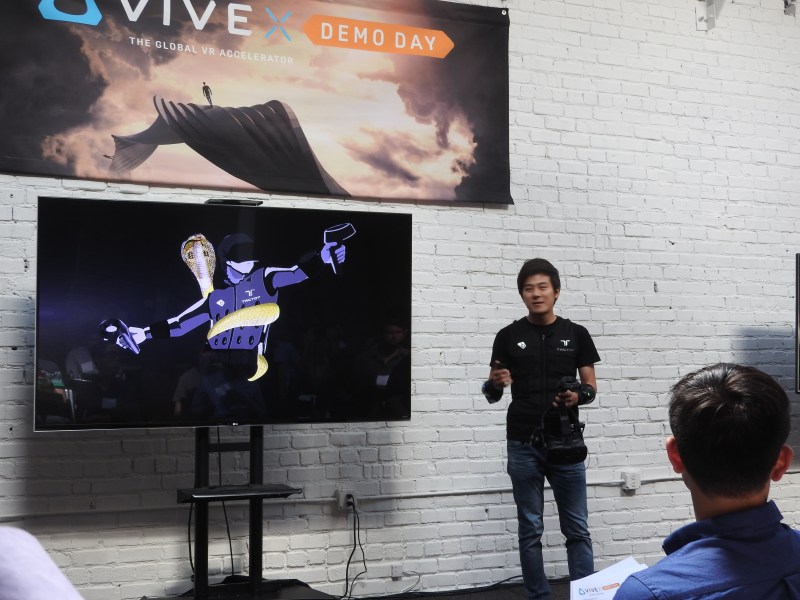HTC has bet big on virtual reality with its HTC Vive VR headset. It continues to believe in the market, and it showed off technology from 26 new companies today at its Vive X accelerator demo day in San Francisco.
HTC has set up a $100 million fund to invest in VR companies, and it has made 60 investments so far across five different accelerator locations in China, the U.S., Taiwan, and Israel.
Here’s the enterprise VR companies:

Above: Hyperfair at Vive X Demo Day.
- Hyperfair is using VR to modernize human resources. It is using VR for recruiting based on avatars, and it is using VR for both internal and external company events. It enables thousands of concurrent users in a VR environment. Such events can be much more engaging in VR, according to Hyperfair. The company is focusing on large accounts.
- Mindesk is creating VR software for computer-aided design. It leverages VR to improve the performance and visualization that is possible with 3D modeling tools. VR can improve performance has much as 100 percent compared to 2D CAD software. It makes prototyping easier and collaboration more productive. It has already had 1,500 downloads and there are more than 100 alpha testers. HP is one of its first paying customers.
- Realiteer uses its WiseMind platform to treat psychiatric patients in VR. It tries to retrain your brain to recover normal functions of the body in the wake of some kid of accident. Few people keep up with their therapy treatments in real life, but patients are more interested in the “gamified” VR platform. So they adhere to their treatment better because of the VR immersion. It has been reviewed by more than 50 therapists. It has had 600,000 downloads. It sells software and hardware bundles to clinics, and the systems can be billed to insurance companies. Eventually, Realiteer will sell to consumers. The company is raising $1 million to conduct clinical trials and set up distribution.
- PlusOne builds interactive intelligent virtual tutors to train students in learning languages. The user can talk to an AI character who can communicate with the user and give feedback on things like pacing, pronunciation, and other tasks. It has been piloted in Japan and China. It is focused on the global online language learning market, a $54 billion opportunity.
- Opaque Space has created a technology dubbed Earthlight for creating 3D simulations for things like training astronauts in virtual reality for space missions. It is working with NASA to develop VR training tools for the next generation of astronauts. It hopes to work with private space companies, government agencies, and eventually consumers. It has demoed to more than 4,000 people so far. It hopes to raise $6 million.
- Snobal is a profitable VR company. That’s right. It is providing VR tools for businesses. It enables them to create, manage, and analyze their VR projects. It is targeting markets such as construction. It has patents for VR related to asset management, commerce, and engagement. It is hoping to raise $6 million.
- SoccerDream is focused on helping people learn how to play soccer using VR. Yes, some people try to do this by kicking a ball around. But that’s old-fashioned. In this case, players learn how to make plays and score goals, based on training tips in the VR app. It teaches physics, technique, and tactics. Right now, only a few top teams have this kind of training, the company said. SoccerDream wants to scale this training to the 24 million U.S. soccer players and others around the world. It uses experts such as members of Chelsea F.C. and other teams.
- Xitaku is focused on augmented reality applications for industrial and medical fields. It has created ARcore, the core camera component of video pass-through systems that film scenes and deliver good quality video. It makes any VR screen AR-enabled. It had revenue of $500,000 in the last year thanks to customers such as the Japanese government.
Here’s the companies doing games:

Above: Vrani is making VR party games.
- Subdream Studios is making VR games with a social twist. It was founded by Jikhan Jung and the team spun off from Colopl. It has already raised $1.55 million. Jung previously worked at companies such as Gala-Net and Kabam. Within five months, it released two games, including Mega Overload, which is like a VR version of the old arcade game Galaga (which consumed a lot of my quarters when I was young). It also created Kingdom Watcher with funding from Samsung. The company is doing both VR and mobile games as it awaits growth of the VR market. It is looking to raise another $450,000.
- The Rogue Initiative is helping Hollywood get into VR. It is creating multiplatform content, ranging from games to non-game VR firms. Michael bay is a co-owner of the company, and they’re working on something based on a big intellectual property (still secret). The first project is Crowe: The Drowned Armory. It’s a VR game with fancy 3D-animated graphics of monsters and heroes in a fantasy world. The company’s staff includes Pete Blumel, CEO, former developer at Infinity Ward on Call of Duty games. It has raised a first round and is looking for more money.
- Pop Match is a new startup from Chip Sineni and Andy Kniaz, and their team created The Brookhaven Experiment, a groundbreaking VR game. It is making a team-based VR sci-fi shooter called Rushfire, and it is coupling that with a system where fans can compete with each other via Pop Match. It groups players for prizes ranging from $1 to $4 at the outset. It will license this skill-based match system to other companies as well. The company wants to raise $2 million to finance a year of development.
- Red Accent is creating sports and adventure games with a team based in Shanghai and San Francisco. Its first tilte is a basketball game where players can move, pass, and shoot. It wants to move into esports. It has veterans from the 2K Sports team, with members who worked on NBA 2K Online. It is headed by cofounders Julien Bares and Greg Gobbi. They hope VR sports games will be a $1 billion market by 2020. The company is building three games in the next 18 months, including location-based entertainment, location-based esports, and a home and mobile VR title. It has backing from NetEase Capital, and it is raising $1.5 million.
- Watch out for that baseball bat. Appnori is creating a VR game with a real baseball bat. It uses the HTC Vive Tracker, a motion sensor that can be attached to objects like a baseball bat. The company is also working on a ping pong game based on the Tracker. It is targeting esports fans and those who like traditional sports. The company has five more games in its pipeline. It is backed by the Korea Creative Content Agency, a South Korean government agency, and it is raising $2 million.
- Vrani is making VR games for kids. About 75 percent of VR titles are violent. The company wants to provide an alternative with party games for families. One of its titles is Ttoring in Wonderland, based on Alice in Wonderland. It’s a title with a bunch of mini games, like shooting a sling shot, climbing rocks, or making a pig sneeze. It hopes to create toys based on the characters in its games, and it is targeting arcades, malls, and theme parks. The company is raising $1 million to finish developing its games, including one that will launch in the third quarter.
Here’s the hardware startups:

Above: B Haptics is making a VR suit.
- Memora is creating a hardware platform for 360-degree VR cameras. It has created its own Luna Cam for VR, with software for making VR apps cross-platform, and stitching videos from multiple cameras together. It has technology to stabilize images. That means you can roll the Luna Cam on the ground and it will create stable imagery. It also has a smart browser for VR so you can view the images you take with the camera more easily. It will charge users a subscription fee for storage, and it is working on a next-generation Linux-based camera, the Luna 2. It was founded by JC Ko and Webber Hsu. It is seeking $1 million in funding.
- B Haptics is creating a full-body and fully programmable haptic suit for VR. With it, you’ll be able to experience applications like a snake crawling over your body. the suit has 87 vibration points for haptic, or touch, feedback. It gives you haptic feedback on your head, arms, chest, and hands. You get force feedback, as if you got hit by a real object, in games that make use of the hardware. You’ll really feel it when someone punches you in the face in VR. Can’t wait for that. It is targeting a price of under $549. It has a sample game, Lotte World’s Zombie Attack, which has been played by 47,000 people in three months. It was founded in May 2015.
- ThermoReal wants to make you feel heat and pain in your VR applications, from games to educational titles. It has created hardware that simulations the feelings that you don’t normally get in realistic VR apps. It has four prototypes done, and it believes people will pay for an added sense of realism from games. It was founded by Kevin Yi, BJ Cho, and Brian Yoo. Thermo Real is seeking $5 million in funding. Hardware isn’t cheap.
- Aurora Optics is building a new generation of AR glasses. The company is targeting high-end features such as a 135-degree field of view and daylight viewability. It is creating an embeddable optic display module for AR headsets, available for purchase in the fall of 2017. It is licensing its optics technology and module to industrial partners. It is raising $1 million.
- Broken Colors is placing sensors close to your face to capture your expressions. And it is trying to make them affordable. It has made a mobile VR headset with eye-tracking built into it. It hopes to collect data from those signals and deliver those in an anonymized way to advertisers and big data companies. Over time, the company wants to capture gestures, speech, heart rate, face expressions — all at a low cost, the company promises.
Here’s the companies working on tools and services

Above: Limitless makes it easy to animate in VR.
- Cognitive VR is making AR/VR and mixed reality research platforms that tell developers how users are behaving in VR. It plans to provide display analytics on user sessions and collect deep metrics on user behavior. For instance, did a user look at a VR car, or go inside to look at the interior? The company is focuses on enterprises, providing them with market research and product design feedback. Cognitive VR wants to raise $2 million.
- Construct Studio is creating its Vera tool for companies to create VR-ready art assets. You can use the company’s editor to create an asset like a door, put it into a VR scene, and make it fit into the environment in an automated fashion. It works with asset creation tools such as Maya and Unity. The company will make VR asset creation faster and easier. The company is raising $1 million.
- Limitless has made a lot of headway over the past couple of years with character and story creation tools for VR. You can use the tools to create a VR scene from directly inside the scene. Led by Pixar veteran Tom Sanocki, the company is targeting professionals building VR, AR, and MR content. The company has existing customers and some who are in trials, and a $1 million co-marketing agreement with Advanced Micro Devices. Limitless is raising $2 million to $3 million.
- Ova is creating the “Metaverse building,” named after the virtual world from Neal Stephenson’s 1991 novel Snow Crash. Yes, The Matrix film is also part of this company’s presentation. Its tools have been used to create worlds in VR by the military and healthcare. The company received a letter of intent for millions of dollars in government contracts. It is making a tool for non-programmers to make their own VR environments in VR through drag-and-drop tools. The company is raising $5 million.
- Byond is creating a cloud-based VR publishing platform for brands, media companies, and agencies. CNN is using the platform to create VR experiences, while real estate agents are creating virtual walkthroughs. You take a VR asset like a 360-degree image, add clickable features and publish it to the web, mobile VR, or high-end headsets. You can manage and track the performance. It aims to enable VR developers to write once and publish anywhere. It hopes to raise $2 million.
- Invrse Reality is creating an operating system to make interaction with real and virtual worlds seamless. The question is how VR can be a major computing platform if there is no easy way to type, text, or chat within the platform. Invrse Reality plans to leverage the smartphone to do some of this work. It is building a “universal remote” for VR and AR, across platforms, bringing both touch inputs and motion controls to different devices. It will enable people to stay connected while in VR, the Seattle company said.
- Sixense vRetail is the latest company to emerge from Sixense, which has made motion-sensing tools for VR. The vRetail division is using VR to deliver a shopping experience in VR. It lets you try out products, like a drone, before you buy them. You can’t break the products, and you’ll know better what you’re getting.

